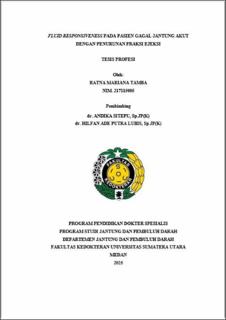| dc.contributor.advisor | Sitepu, Andika | |
| dc.contributor.advisor | Hilfan Ade Putra, Lubis | |
| dc.contributor.author | Tamba, Ratna Mariana | |
| dc.date.accessioned | 2025-10-13T08:40:11Z | |
| dc.date.available | 2025-10-13T08:40:11Z | |
| dc.date.issued | 2025 | |
| dc.identifier.uri | https://repositori.usu.ac.id/handle/123456789/109362 | |
| dc.description.abstract | Background: The concept of fluid responsiveness is analogized as the ability of the myocardium to create an increase of ≥ 10% in stroke volume with the presence of increased preload according to the Frank-Starling Law, which in this study is performed using passive leg raising (PLR) technique. In heart failure patients with reduced ejection fraction, the inability to increase stroke volume occurs due to decreased myocardial contractility and increased left ventricular filling pressure, placing the myocardium on a flat position on the Frank-Starling curve. The aim of this study is to analyze the relationship between fluid responsiveness and increased filling pressure in heart failure patients with reduced ejection fraction and its effects on rehospitalization and mortality events.
Method: This study is an observational analytical study with a cross-sectional design on heart failure patients with reduced ejection fraction being treated for decompensation and planned for outpatient follow-up at Adam Malik Hospital from December 2024 to March 2025. Fluid responsiveness was assessed by an increase in VTI ≥ 10% before and after performing PLR. Filling pressures were evaluated with echocardiographic parameters E/A, E/e’, and PCWP. Logistic regression tests were conducted to assess the relationship between fluid responsiveness and filling pressures, and Chi-square tests to assess the relationship between fluid responsiveness and outcomes of rehospitalization and mortality. A p-value < 0.05 was considered statistically significant.
Results: The research subjects consisted of 65 people, with 28 (43%) patients in the fluid responder (FR) group and 37 patients (57%) in the non-fluid responder (NFR) group. It was found that the filling pressures in the NFR group were higher than those in the FR group, with E/A, E/e’, and PCWP being 0.96 (0.8-1.31); 13.37±6.2; 18.48±7.7 and 1.5 (1.0-2.3); 16.13±5.7; 21.91±7.1 (p<0.005). There was no difference in the incidence of rehospitalization and mortality between the two groups.
Conclusion: No relationship was found between fluid responsiveness and left ventricular filling pressure as well as readmission and mortality rates in heart failure patients with reduced ejection fraction, whether fluid responders or non-fluid responders. | en_US |
| dc.language.iso | id | en_US |
| dc.publisher | Universitas Sumatera Utara | en_US |
| dc.subject | Fluid responsiveness | en_US |
| dc.subject | gagal jantung dengan penurunan fraksi ejeksi | en_US |
| dc.subject | mortalitas | en_US |
| dc.subject | passive leg raising | en_US |
| dc.subject | rehospitalisasi | en_US |
| dc.subject | tekanan pengisian ventrikel kiri | en_US |
| dc.subject | Research Subject Categories::MEDICINE | en_US |
| dc.title | Fluid Responsiveness pada Pasien Gagal Jantung Akut dengan Penurunan Fraksi Ejeksi | en_US |
| dc.title.alternative | Fluid Responsiveness in Patients with Acute Heart Failure Reduce Ejection Fraction | en_US |
| dc.type | Thesis | en_US |
| dc.identifier.nim | NIM217115005 | |
| dc.identifier.nidn | NIDN0012117906 | |
| dc.identifier.nidn | NIDN0019078306 | |
| dc.identifier.kodeprodi | KODEPRODI11715#Ilmu Penyakit Jantung dan Pembuluh Darah | |
| dc.description.pages | 71 pages | en_US |
| dc.description.type | Karya Tulis Profesi | en_US |
| dc.subject.sdgs | SDGs 3. Good Health And Well Being | en_US |


